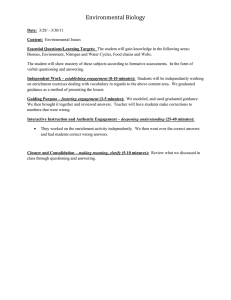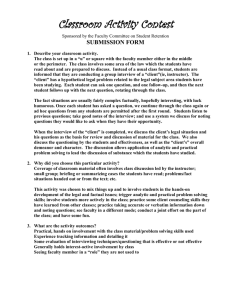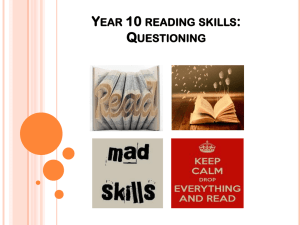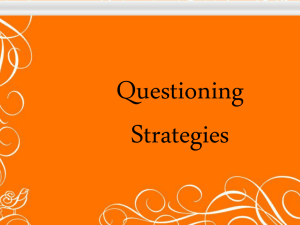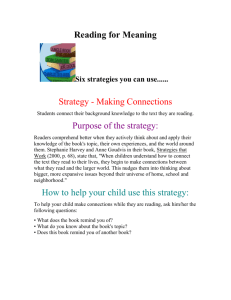Submission 26
advertisement
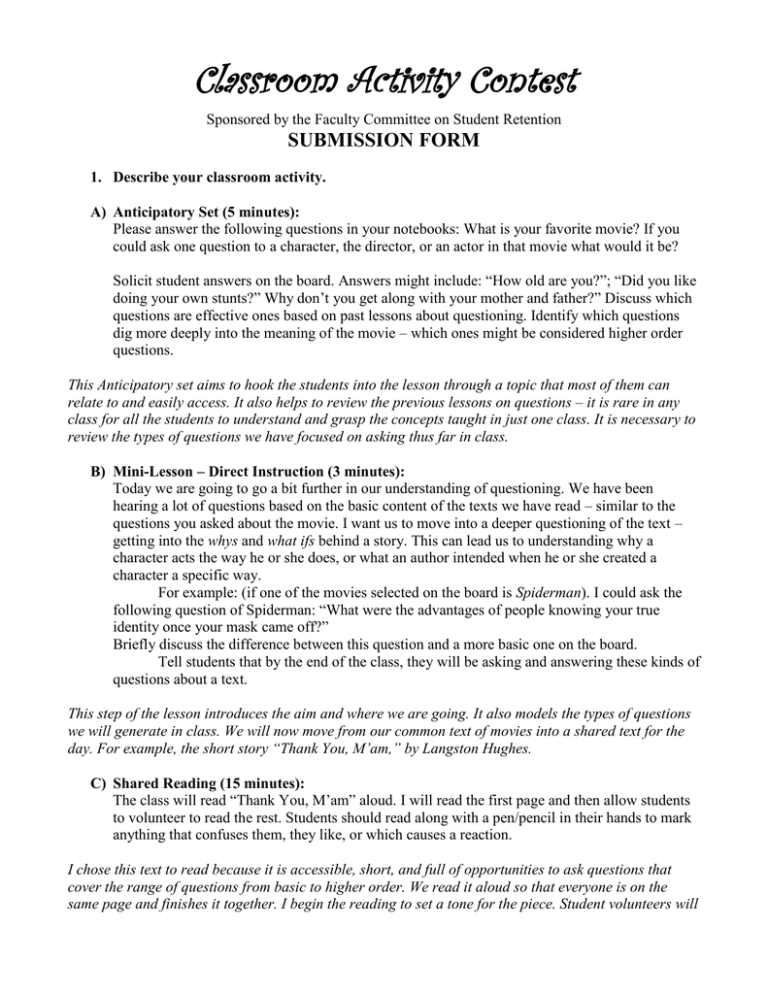
Classroom Activity Contest Sponsored by the Faculty Committee on Student Retention SUBMISSION FORM 1. Describe your classroom activity. A) Anticipatory Set (5 minutes): Please answer the following questions in your notebooks: What is your favorite movie? If you could ask one question to a character, the director, or an actor in that movie what would it be? Solicit student answers on the board. Answers might include: “How old are you?”; “Did you like doing your own stunts?” Why don’t you get along with your mother and father?” Discuss which questions are effective ones based on past lessons about questioning. Identify which questions dig more deeply into the meaning of the movie – which ones might be considered higher order questions. This Anticipatory set aims to hook the students into the lesson through a topic that most of them can relate to and easily access. It also helps to review the previous lessons on questions – it is rare in any class for all the students to understand and grasp the concepts taught in just one class. It is necessary to review the types of questions we have focused on asking thus far in class. B) Mini-Lesson – Direct Instruction (3 minutes): Today we are going to go a bit further in our understanding of questioning. We have been hearing a lot of questions based on the basic content of the texts we have read – similar to the questions you asked about the movie. I want us to move into a deeper questioning of the text – getting into the whys and what ifs behind a story. This can lead us to understanding why a character acts the way he or she does, or what an author intended when he or she created a character a specific way. For example: (if one of the movies selected on the board is Spiderman). I could ask the following question of Spiderman: “What were the advantages of people knowing your true identity once your mask came off?” Briefly discuss the difference between this question and a more basic one on the board. Tell students that by the end of the class, they will be asking and answering these kinds of questions about a text. This step of the lesson introduces the aim and where we are going. It also models the types of questions we will generate in class. We will now move from our common text of movies into a shared text for the day. For example, the short story “Thank You, M’am,” by Langston Hughes. C) Shared Reading (15 minutes): The class will read “Thank You, M’am” aloud. I will read the first page and then allow students to volunteer to read the rest. Students should read along with a pen/pencil in their hands to mark anything that confuses them, they like, or which causes a reaction. I chose this text to read because it is accessible, short, and full of opportunities to ask questions that cover the range of questions from basic to higher order. We read it aloud so that everyone is on the same page and finishes it together. I begin the reading to set a tone for the piece. Student volunteers will Classroom Activity Contest Sponsored by the Faculty Committee on Student Retention continue the reading so that other voices are heard in the classroom. While the story is read, I will stop occasionally and ask basic comprehension questions. For example, “What is a blue-jeaned sitter?” (p.166). What is a half-nelson?” (p. 167). These questions are meant to cover basic vocabulary, and also to model the kinds of questions from which we will be moving. D) Group work (20 minutes): 1) After the reading I will ask the class for examples of basic questions that can be asked about this text. Possible answers could be: “Who are the characters in this story?” “What does Roger want to do with the money he steals?” I will write these on the board. This allows students to review, hone and be more aware of their basic questioning skills. It models the kinds of questions from which we will be moving, and it also enables us to get the facts of the story down so we are all on the same page in our general understanding of the story. 2) I will ask if there are other questions that might have arisen about the text during our shared reading of it and then write those on the board. Some questions could be: “Why did Mrs. Jones take Roger home with her instead of calling the police?” “Why does she give him $10 after he tried to rob her?” (If these questions cannot be solicited from the class, I will model them). Soliciting these questions from the students allows them to see that they already know how to ask higher order questions based on their general curiosity. It also allows me to assess if they are thinking about the text on this level. If they are not asking me these questions, then I will model for them what I am looking for. If they come up with basic comments about the text, then we will discuss how to turn those comments into questions. 3) Students will talk for three minutes in pairs to answer one of the questions on the board. They will also discuss how their answer to this question differs from the answers to the basic comprehension questions asked earlier. Brief share as a full class, and debrief how the analytical question differs from the comprehension question and where they found their answers. Record answers on the board. Students will get a chance to talk about the story more in depth during this step. Debriefing is meant as a form of self-reflection where students become more conscious of their process as thinkers, as well as what makes the questions and answers different. Note: this step can be eliminated based on how the class is doing during the lesson. If I see they all grasp the concept well, we can move onto the next activity. E) Independent Activity (30 minutes): 1) Students will independently re-read “Thank You, M’am” and write at least 3 questions they have about the text in the margins as they read. This is to reinforce their reading with a pen/pencil in their hands so they can mark up the text and actively engage in it. They can direct Classroom Activity Contest Sponsored by the Faculty Committee on Student Retention the question towards a character, the author, or the main plot in general. (For example, “Mrs. Jones, why were you so nice to Roger? What did you have to gain from it?) Now students are given the chance to work independently and put into practice what we went over in class. An informal assessment of student comprehension will be done during this time. A great deal can be learned about a student’s understanding of a text through what kinds of questions they ask. I will circulate around the room and work independently with those students who need it. I will also visually assess how the students are doing by how they mark their papers, and the questions they write. 2) Students will choose and circle one of their questions, which they will then write on a Post-it note. Once they write their question, they will get up and put it on the blackboard at the front of the room. Students should be told that each one of them is responsible for posting one question and must answer one as well. They do not have to put their name on the Post-it note, but they will have to put it on their answer sheet. This step allows students to get out of their seats and display their work visually. It also encourages full participation from the members of the class since each student is accountable for his/her own question. Please refer to Appendix B to see a potential sample of questions asked and what the board might look like. Keeping the questions anonymous for this part of the activity creates mutual respect amongst the students because no one will intentionally foul up another person’s response. It also might encourage more reluctant students to participate because they will not feel immediately judged by their peers. 3) Once the questions are posted, ½ the class will go to the board and review the questions. Each student will take a question that he/she feels he/she can answer. The other half of the class will go to the board once the first half sits down. This can vary depending on the number of students in the class. However, it is best to split the class so there is more room for students to read the questions on the board. This step also allows each student the freedom to choose a question they feel comfortable answering. 4) Students will place the Post-it note on top of a blank piece of loose leaf paper, and then they will answer the question they chose by writing directly below the Post-it note. Students can answer the question directly, or they can answer in the voice of the character. There is no such thing as a right or wrong answer. If students are confused, where can they look to find the answer? Refer to the discussion held during the group work section of the class. Try to point to the text when you can to help support your answer. In this step, students will discuss the story with each other through a silent discussion on paper. This method of discussion allows for each person’s voice to be heard, since it is done in a private, written format and not in the arena of an open class discussion where oftentimes the same three students dominate. This form of discussion allows for students to challenge and respond to each other. It also encourages everyone to participate and express their opinions, or confusion, about the text. 5) Students will share with a partner and then share as a class. Classroom Activity Contest Sponsored by the Faculty Committee on Student Retention The class will end with a sharing of each other’s work so that we can begin our evaluation of the questions asked and how they were answered. In the past, students have given positive feedback to this lesson because they said they felt like they completed something tangible during it. F) Homework: Answer the following questions in complete sentences: 1) Why did you choose the question you did to answer? 2) What did you notice about the question you answered versus the one you wrote? How did the two differ? (For example, Does your question focus on the setting of the story, while your partner’s focuses on character?) 3) How did your understanding of “Thank You, M’am” change, if at all, from answering the question you did? How did your partner’s question lead you to any ideas you might not have considered? This homework assignment aims to be a self-reflection in which students will review their process in this assignment, as well as evaluating and reflecting on their peers’. G) Extensions and/or Adaptations: If I find that the class on the whole is doing well, we can boost their reading of this text by examining it through critical lenses, such as stereotypes, how the past influences the present, and conflict. If the class is having difficulties with questioning this text, we can return to discussing a common text like a TV show or a movie. Once the class has fully understood the questioning concept using a TV show as an example, we can then move back into Hughes’ text. 2. Why did you choose this particular activity? How do we understand how to think critically about a text? This lesson focuses on strengthening critical reading skills, in particular the reading strategy of questioning the text. Good readers ask questions of the text in order to develop a deeper understanding of such elements as plot, character, author’s purpose and relation to other texts and/or personal experiences. Proficient readers interact with the text while they read, keeping it fluid and active. This helps the reader to maintain focus and comprehension. Questioning the text is one reading strategy that can keep reluctant readers from tuning out and letting their minds go elsewhere. This particular lesson aims to strengthen students’ questioning skills so they can further open the text, explore it and gain a deeper understanding of it. Students will learn, through questioning a text, how to better synthesize their ideas and back up their opinions with supporting details. This lesson will help students become active readers with the text, as well as actively engage with each other – they will discuss their ideas with their classmates through written dialogues. This is done to facilitate a class discussion in which each student voice is heard and validated. 3. What are the activity outcomes? The activity results in each student becoming involved in the class discussion at a low-risk level. Not only does each student have the opportunity to share his/her opinion and voice, but he/she is also held Classroom Activity Contest Sponsored by the Faculty Committee on Student Retention accountable for his/her work because another student’s work depends upon the completion of it. In addition, students like feeling they have completed something by the end of the class. 4. What were the intended activity outcomes? Students will generate at least three different kinds of questions about a text, as well as exhibit reading comprehension through answering one question generated by a classmate. By generating and answering their own questions, students will gain more ownership over the text and the class discussion. In generating and answering the questions, students will also be honing reading skills such as re-reading, inferring, and considering point-of-view.
